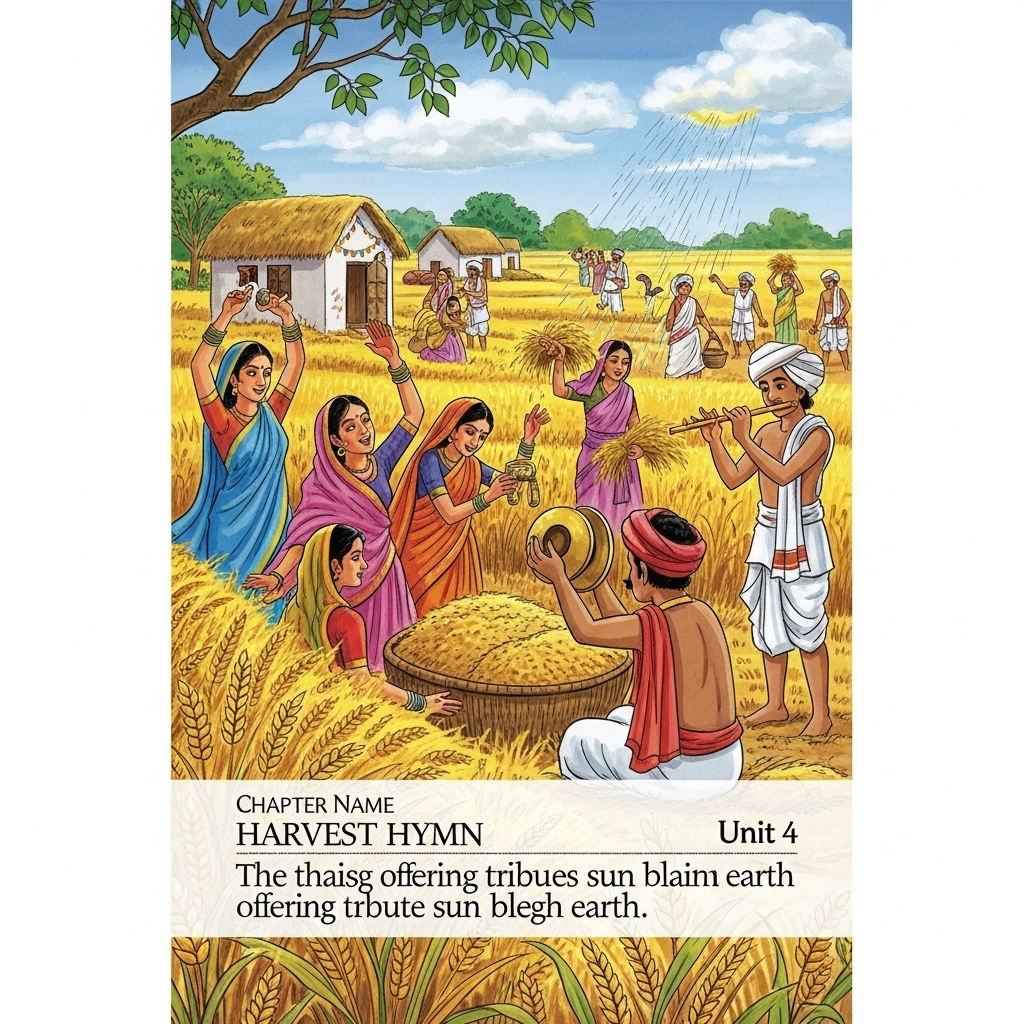Complete Solutions and Summary – Harvest Hymn – NCERT Class 8, English, Unit 4 – Summary, Questions, Answers, Extra Questions
Detailed summary and explanation of Unit 4 ‘Harvest Hymn’ with all question answers, extra questions, and solutions from NCERT Class VIII English (Poorvi).
Updated: 1 month ago

Introduction
"Harvest Hymn" is a beautiful and reverent poem that celebrates the harvest season in rural India by praising natural elements and divine forces responsible for bountiful crops. The poem is divided into voices of men, women, and a collective chorus, expressing gratitude and respect for the sun, rain, earth, and the universal creator. Its rich use of metaphor, symbolism, and imagery captures the deep spiritual and cultural connection between people and the environment during this important agricultural season.
Summary in English (200 words):
The poem offers heartfelt praise to Surya (the Sun), Varuna (the Rain), Prithvi (the Earth), and Brahma (the Creator). Each voice recognizes the contribution of these forces in nurturing crops and supporting life. The speakers dedicate their songs, labors, and harvest as tribute, seeking blessings and guidance. The hymn emphasizes unity, respect, and the cyclical nature of life and agriculture, creating a joyous and sacred atmosphere around harvest time.
Summary in Hindi (200 words):
यह कविता सूर्य, वरुण, पृथ्वी और ब्रह्मा की स्तुति करती है, जो कृषि और जीवन के पोषण के लिए जिम्मेदार हैं। कविता में पुरुष, महिला और सभी आवाजें इन शक्तियों को धन्यवाद और श्रद्धांजलि अर्पित करती हैं। वे अपने गीत, श्रम और फसल को समर्पित करते हैं और आशीर्वाद और मार्गदर्शन मांगते हैं। यह कविता एकता, सम्मान और कृषि के चक्रीय जीवन को उजागर करती है और फसल के समय की खुशी और पवित्रता को दर्शाती है।
Thinking about the Poem – Harvest Hymns
-
1. What is the main theme of the Harvest Hymn?
The main theme is praise and gratitude for the bounty of the harvest and the natural forces like sun, rain, and earth that make it possible.
-
2. Which deities or natural elements are addressed in the hymn?
The hymn addresses Surya (Sun), Varuna (Rain), Prithvi (Earth), and Brahma, symbolizing the forces behind the harvest.
-
3. How do the farmers express their connection with the harvest in the poem?
They express deep respect through songs, offerings, and acknowledgments of the harvest's importance for their sustenance.
-
4. What literary devices are predominantly used in the Harvest Hymn?
The poem employs symbolism, repetition, imagery, and personification to elevate natural elements into revered entities.
-
5. Why is the hymn divided into voices of men, women, and all voices?
This division symbolizes community participation and reflects the collective cultural celebration of the harvest.
-
6. What role does repetition (such as “gold”) play in the poem?
Repetition emphasizes abundance and prosperity, reinforcing the celebratory and thankful tone of the hymn.
-
7. How is the Earth personified in the hymn?
Earth is portrayed as a nurturing mother, highlighting fertility and the giving nature of the planet.
-
8. What imagery does the hymn use to describe the harvest and nature?
The hymn uses vivid descriptions of ripe fields, singing birds, dewfall, and fruitful valleys to evoke sensory experiences.
-
9. What is the significance of offerings like songs and garlands in the hymn?
These offerings symbolize respect and reverence for the divine forces responsible for a successful harvest.
-
10. How does the hymn promote a message of sustainability?
By honoring natural forces and emphasizing their role in human survival, the hymn encourages respect and care for the environment.
Detailed Questions – Harvest Hymns
-
1. Analyze the symbolism of the “Seed” and the “Scythe” in the Harvest Hymn.
The Seed symbolizes the beginning of life and growth, while the Scythe represents harvest and reaping; together, they portray the cycle of growth and maturation in agriculture.
-
2. How does the poem balance the depiction of male and female roles in rural agricultural life?
By dividing voices into men, women, and all voices, the hymn recognizes distinct contributions while promoting unity in celebration and labor.
-
3. Examine how the hymn’s tone and structure reflect its cultural significance.
The tone is reverential and joyous, with a structured progression of voices and invocation, reflecting tradition and communal harmony in agrarian culture.
-
4. Discuss the use of personification in the hymn and its impact on the reader.
Personification elevates natural elements to divine figures, creating emotional connection and reverence, making readers appreciate nature’s role deeply.
-
5. What lessons about human dependence on nature can be drawn from the Harvest Hymn?
The hymn highlights humans’ reliance on natural forces for survival and prosperity, teaching respect, gratitude, and stewardship of the environment.

Group Discussions
No forum posts available.


